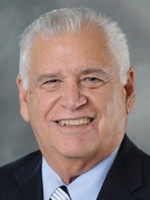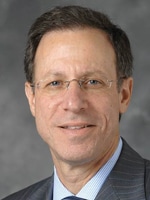Anne Ford
September 2018—Ten years ago, Richard J. Zarbo, MD, was feeling pretty proud of his laboratory. As system chairman of pathology and laboratory medicine at Detroit-based Henry Ford Health System, over the previous few years he’d seen his team rigorously implement Lean practices, practices that had paid off in greater safety and efficiency. “Setting the bar higher was important because that’s the culture here,” he says. “This is what we do.”
Then he encountered his first CAP 15189-accredited laboratory, and knew the game had changed: “We thought we were pretty good at what we did, until we saw what Leo did.”
That would be Leo Serrano, then the administrative director of Avera McKennan Hospital and University Health Center, Sioux Falls, SD—the first hospital laboratory in the nation to be accredited by the CAP for ISO 15189. “I was just blown away with the level of discipline that I saw there, and that’s what prompted me to bring the vision of 15189 as a systemwide stretch goal to my own team,” Dr. Zarbo says.
Ten years later, Henry Ford is just one of 67 laboratories that have achieved CAP 15189 accreditation, with more than a dozen others having applied or in process. In the decade since the CAP introduced the program, which accredits laboratories to the International Organization for Standardization’s 15189 standard, it has gained a rock-solid reputation as the premier method for reaching excellence in medical laboratories.
As Dr. Zarbo puts it: “ISO is really the status of the few. Anybody can buy and drive a Cadillac, but very few get to drive a Porsche. When you’re doing ISO as a laboratory, you’re driving a Porsche. There are not many other people on the highway with you.”
On the 10th anniversary of the CAP 15189 program, three institutions share how undertaking this rigorous program has changed their practices and outcomes for the better.
A decade after his then-laboratory achieved 15189 accreditation, Serrano calls it “the highlight of my career.”“It’s a long road, a trying road, and an extremely rewarding road,” says Serrano, who is now clinical and operational consultant and operations manager for FirstPath, a Fort Lauderdale-based pathology group. “The lessons you learn from 15189, you carry forth into all of your future efforts.”
Like Henry Ford Health System, Avera McKennan had already implemented Lean practices before it ever considered adding 15189. “Because we were Lean fanatics, if you will, our turnaround times were very tight and very consistent, and those kinds of metrics that Lean and Six Sigma labs like to use were already in place,” Serrano explains.
So why add 15189? “The way we sold the concept to our administration was that it would validate the quality of our laboratory,” he says. “We had participated in a number of quality surveys, and we always came out as a shining star. But that’s just somebody else’s opinion. Having 15189 accreditation meant that an outside independent neutral arbiter had come in and said: ‘You meet the highest standard possible.’”
In addition to the considerable bragging rights that accompanied becoming the first U.S. hospital laboratory to be CAP 15189 accredited (for that he credits the full Avera lab team, particularly Cheryl Wildermuth, laboratory quality management manager), the accreditation did several things for Serrano’s staff. First, it motivated and unified them in a tremendous way. “As we explained what 15189 was going to do for us, everybody bought into it, and it became the glue that bonded the entire laboratory,” says Serrano. “Organizationally, emotionally, and in many other ways.”

‘Our research institute
was immediately awarded a half-million-dollar contract.
And as we improved, that translated into better marketing tools, which helped us get even more outreach work.’ — Leo Serrano
The accreditation brought unexpected business benefits as well. “As soon as people saw that we were the first ISO 15189 hospital laboratory, our research institute was immediately awarded a half-million-dollar contract,” he says. “And as we improved, that translated into better marketing tools, which helped us get even more outreach work. Because of that, we were able to keep the ‘blood brothers’ from really having any impact whatsoever in our market area.” Avera recently achieved CAP 15189 reaccreditation for the third time.
Though his current institution, FirstPath, is not 15189 accredited, it’s just a matter of time, Serrano says. “The things that I’ve learned from when we did them at Avera, we have applied a great many of those at FirstPath. The owners of FirstPath have bought into the whole thing, lock, stock, and barrel. So we have started gearing in that direction.”
Until then, he has a memento to help keep the 15189 inspiration alive. When the Avera McKennan laboratory personnel first learned they had achieved ISO accreditation, they all streamed onto the hospital grounds for a group picture. A copy of it still sits in Serrano’s home office.
“That’s a constant reminder,” he says. “We wanted to be number one above all. We wanted to be the best we could possibly be. And if you have that same drive, then 15189 is what you want to achieve, because that’s the ultimate designator of a top-quality laboratory.”
After Dr. Zarbo saw the freshly 15189-accredited Avera McKennan laboratory, he returned to his Henry Ford team and told them: “We have to go another notch up.”For example? Lean-saturated as it was, the laboratory already documented defects in the workplace via a deviation management system. “In our first year, I think we documented about 8,000 things that were defective in the work or didn’t please the customer or didn’t go well and had to be reworked and redone,” he recalls. After HFHS achieved CAP 15189 accreditation (becoming, at the time, the largest entity to do so) in 2013, the laboratory continued and amplified those efforts. “So we now document over 70,000 defects annually,” he says. “And we do it in a defined manner that starts to document the root cause, documents the corrective action, and documents the preventive action. So think about how this laboratory looks now, as compared to six or eight years ago.”
Quality systems manager Ruan Varney knows exactly how it looks. “We started with 125 subclassification codes in the first year and consistently grew to over 300 in 2018. Each manager is equipped with a monthly summary chart of their most frequent deviations to engage their staff as well as their external supplier for improvement opportunities.” They recently began an improvement process with the emergency department in hopes of reducing the number of clinical blood samples submitted to the laboratory that are categorized as “quantity not sufficient” and “clotted” by sharing data from the deviation management system.
“The latest enhancement in the deviation management system is to be able to narrow down to the phlebotomist who drew that specimen to understand the underlying root causes for improvements. This is huge for us and very exciting,” Varney says, explaining that the hope is to expand the pilot to other areas of the hospital. “We monitor the ongoing progress of this pilot with a daily metric board shared with the ED. While reducing the risk to patients, we have also earned a higher level of respect from our customers.”
Dr. Zarbo points to document control as another example of an area in which 15189 has made a big difference. “The College required us to have document control, and that was usually a paper-based system,” he says. “But if you’re going to do things so that all your policies and procedures are standardized across all laboratories in a system of almost 1,000 people, you have to be electronic. We realized that unless we had an electronic document system we could not pursue ISO.”
Since implementing that electronic document control as part of the 15189 accreditation requirements, the laboratory now has more than 10,000 documents in its EDS. All of the laboratory manuals are kept on the lab’s intranet, so that any employee anywhere in the system can consult them or print them out at any time. “This is a direct result of our quest for ISO,” Dr. Zarbo says.
One undertaking that was completely new to the laboratory at the time it began the 15189 accreditation process was the internal audits requirement. “The goal is to find things that people who do the work take for granted and don’t see as deficiencies,” he explains. “So we do this auditor work throughout the year of all laboratories in the system. And what has been the outcome? Almost every single laboratory under our direction has had a 90 percent decrease in Laboratory Accreditation Program deficiencies since we began this process.”
Varney says the laboratory has also seen a vast improvement in turnaround times since becoming 15189 accredited. “Previously, a prostate resection, for example, would have taken up to seven days to result; now it takes two days from receipt in the laboratory,” she says. “We also receive breast biopsy specimens the same day or next morning from our affiliate hospitals. That very same day the breast specimens are accessioned and processed and glass slides are delivered to the pathologists.” The significantly shorter turnaround times are monitored at each stage with a daily metric board. “We know when it was packaged for delivery from the site, when it was taken off the delivery log, when it was grossed and delivered to the pathologist. We have our clinicians complimenting us: ‘I don’t know what you guys do, but it is amazing—we have our results, we can expedite the patient appointments, and get them to the clinic faster for their management.’”

‘Almost every single
laboratory under our
direction has had a
90 percent decrease in
Laboratory Accreditation
Program deficiencies
since we began this process.’ — Richard Zarbo, MD
There are improvements in clinical pathology as well. Before 15189, it wasn’t unusual for a critical value phone call to be made to a physician at 2 AM regarding a specimen from a patient who had been seen at 10 AM that day. “Because of multiple continuous process improvements, we now call the clinician within about four hours of specimen collection,” Varney says. “When the call is made earlier in the same day, the clinician has a chance to attend to the patient earlier rather than our waking up the clinician in the middle of the night and the patient being sent to the ER.”
The 15189 standard requires management review. “We actually had a number of consultants with us years ago,” Dr. Zarbo says. “Their advice was to focus on only a certain aspect of management and just do a deep dive on that. We thought: That’s not really good enough for us as a system laboratory, so we’re going to do our own reflective self-inspection of every single management system that we have and whether it delivers on the goal of quality and human engagement, year after year after year.” It’s this approach, he says, that has led to a 35 percent drop in the rate of most common deficiencies.
 CAP TODAY Pathology/Laboratory Medicine/Laboratory Management
CAP TODAY Pathology/Laboratory Medicine/Laboratory Management
